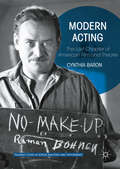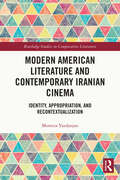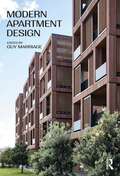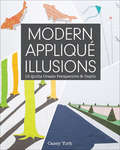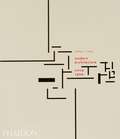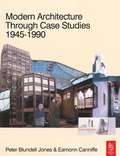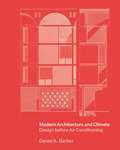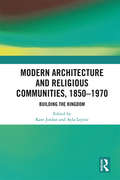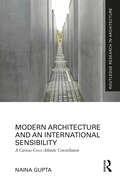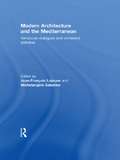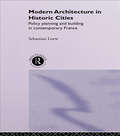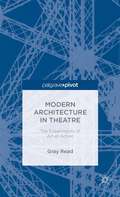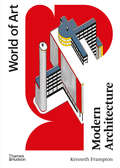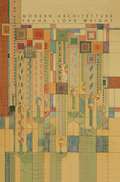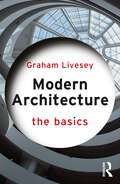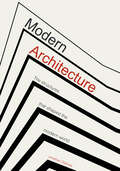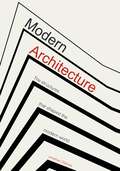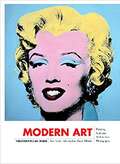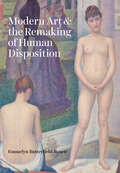- Table View
- List View
Modelwork: The Material Culture of Making and Knowing
by Martin Brückner Sarah Wasserman Sandy IsenstadtHow making models allows us to recall what was and to discover what still might be Whether looking inward to the intricacies of human anatomy or outward to the furthest recesses of the universe, expanding the boundaries of human inquiry depends to a surprisingly large degree on the making of models. In this wide-ranging volume, scholars from diverse fields examine the interrelationships between a model&’s material foundations and the otherwise invisible things it gestures toward, underscoring the pivotal role of models in understanding and shaping the world around us. Whether in the form of reproductions, interpretive processes, or constitutive tools, models may bridge the gap between the tangible and the abstract.By focusing on the material aspects of models, including the digital ones that would seem to displace their analogue forebears, these insightful essays ground modeling as a tactile and emphatically humanistic endeavor. With contributions from scholars in the history of science and technology, visual studies, musicology, literary studies, and material culture, this book demonstrates that models serve as invaluable tools across every field of cultural development, both historically and in the present day.Modelwork is unique in calling attention to modeling&’s duality, a dynamic exchange between imagination and matter. This singular publication shows us how models shape our ability to ascertain the surrounding world and to find new ways to transform it. Contributors: Hilary Bryon, Virginia Tech; Johanna Drucker, UCLA; Seher Erdoğan Ford, Temple U; Peter Galison, Harvard U; Lisa Gitelman, New York U; Reed Gochberg, Harvard U; Catherine Newman Howe, Williams College; Christopher J. Lukasik, Purdue U; Martin Scherzinger, New York U; Juliet S. Sperling, U of Washington; Annabel Jane Wharton, Duke U.
Modern Acting
by Cynthia BaronEveryone has heard of Method acting . . . but what about Modern acting? This book makes the simple but radical proposal that we acknowledge the Modern acting principles that continue to guide actors' work in the twenty-first century. Developments in modern drama and new stagecraft led Modern acting strategies to coalesce by the 1930s - and Hollywood's new role as America's primary performing arts provider ensured these techniques circulated widely as the migration of Broadway talent and the demands of sound cinema created a rich exchange of ideas among actors. Decades after Strasberg's death in 1982, he and his Method are still famous, while accounts of American acting tend to overlook the contributions of Modern acting teachers such as Josephine Dillon, Charles Jehlinger, and Sophie Rosenstein. Baron's examination of acting manuals, workshop notes, and oral histories illustrates the shared vision of Modern acting that connects these little-known teachers to the landmark work of Stanislavsky. It reveals that Stella Adler, long associated with the Method, is best understood as a Modern acting teacher and that Modern acting, not Method, might be seen as central to American performing arts if the Actors' Lab in Hollywood (1941-1950) had survived the Cold War.
Modern American Drama on Screen
by William Robert Bray R. Barton PalmerFrom its beginnings, the American film industry has profited from bringing popular and acclaimed dramatic works to the screen. This is the first book to offer a comprehensive account, focusing on key texts, of how Hollywood has given a second and enduring life to such classics of the American theater as Long Day's Journey into Night, A Streetcar Named Desire and Who's Afraid of Virginia Woolf? Each chapter is written by a leading scholar and focuses on Broadway's most admired and popular productions. The book is ideally suited for classroom use and offers an otherwise unavailable introduction to a subject which is of great interest to students and scholars alike.
Modern American Literature and Contemporary Iranian Cinema: Identity, Appropriation, and Recontextualization (Routledge Studies in Comparative Literature)
by Morteza YazdanjooAs an endeavor to contribute to the burgeoning field of comparative literature, this monograph addresses the dynamic yet understudied "intertextual dialogism" between modern American literature and contemporary Iranian Cinema, pinpointing how the latter appropriates and recontextualizes instances of the former to construct and inculcate vestiges of national/gender identity on the silver screen. Drawing on Louis Montrose’s catchphrase that Cultural Materialism foregrounds "the textuality of history, [and] the historicity of texts", this book contends that literary "texts" are synchronic artifacts prone to myriad intertextual and extra-textual readings and understandings, each historically conditioned. The recontextualization of Herzog, Franny and Zooey, The Glass Menagerie, A Streetcar Named Desire, and Death of a Salesman into contemporary Iran provides an intertextual avenue to delineate the textuality of history and the historicity of texts
Modern Apartment Design
by Guy MarriageModern Apartment Design provides guidelines to the design of modern apartment buildings as well as a summation of current cutting-edge practice in engineered timber construction. The book covers a brief history of apartment buildings around the world, with a broad outline of different types of apartment blocks. It has a strong focus on the design and actual construction of apartment buildings, especially those utilising mass timber, such as cross-laminated timber and laminated veneer lumber. It also features six Case Study chapters from industry-leading practitioners in the area, enabling best practice in architecture and engineering of these new apartment building types to be more widely understood and propagated worldwide. The fully illustrated, full-colour case studies span the globe and include: Clearwater Quay in Christchurch, New Zealand (Pacific Environments NZ); Wynyard Central East 2 in Auckland, New Zealand (Architectus); Dalton Works in London, UK (Waugh Thistleton Architects); Mjøstårnet, Brumunddal, Norway (Voll Arkitekter); Brock Commons Tallwood House student housing in Vancouver, Canada (Acton Ostry Architects); and Regensbergstrasse apartments in Zurich, Switzerland (Dreicon). The book will be of great interest to architects and architecture students.
Modern Appliqué Illusions: 12 Quilts Create Perspective & Depth
by Casey YorkThe award-winning quilter and appliqué designer brings fine art principles to 12 stunning quilts in this surprisingly simple step-by-step guide.Casey York pushes creative boundaries in the quilting world with her graphic, contemporary designs and patterns. In Modern Appliqué Illusions, she combines easy quilting methods with the fine art secrets of depth and perspective to create modern quilted optical illusions. Though these sophisticated look like museum pieces, they are designed for everyday use.In Modern Appliqué Illusions, you will learn to create landscapes that recede into the distance, objects that look three-dimensional, even fish that seem to swim underwater—all with easy raw-edge appliqué and straight-line machine quilting! Hand stitching finishes the appliqué with a clean look that still has a handmade feeling.
Modern Architecture Since 1900
by William J. R. CurtisA penetrating analysis of the modern architectural tradition and its origins. Since its first publication in 1982, Modern Architecture Since 1900 has become established as a contemporary classic. Worldwide in scope, it combines a clear historical outline with masterly analysis and interpretation. Technical, economic, social and intellectual developments are brought together in a comprehensive narrative which provides a setting for the detailed examination of buildings. Throughout the book the author's focus is on the individual architect, and on the qualities that give outstanding buildings their lasting value. For the third edition, the text has been radically revised and expanded, incorporating much new material and a fresh appreciation of regional identity and variety. Seven chapters are entirely new, including expanded coverage of recent world architecture.
Modern Architecture Through Case Studies 1945 to 1990
by Peter Blundell Jones Eamonn CanniffeOnce again, new interpretations are presented of some of the most famous architecture of the period. Work by lesser-known architects, whose influence and role have been overlooked by conventional histories of the subject, is discussed. The case study structure allows each example to be discussed and used as a springboard to explore different theoretical approaches. Filled with beautiful photographs, plans and architect's drawings, this is a clear and accessible discussion on a period of architecture that engages many questions still under debate in architecture today.
Modern Architecture and Climate: Design before Air Conditioning
by Daniel A. BarberHow climate influenced the design strategies of modernist architectsModern Architecture and Climate explores how leading architects of the twentieth century incorporated climate-mediating strategies into their designs, and shows how regional approaches to climate adaptability were essential to the development of modern architecture. Focusing on the period surrounding World War II—before fossil-fuel powered air-conditioning became widely available—Daniel Barber brings to light a vibrant and dynamic architectural discussion involving design, materials, and shading systems as means of interior climate control. He looks at projects by well-known architects such as Richard Neutra, Le Corbusier, Lúcio Costa, Mies van der Rohe, and Skidmore, Owings, and Merrill, and the work of climate-focused architects such as MMM Roberto, Olgyay and Olgyay, and Cliff May. Drawing on the editorial projects of James Marston Fitch, Elizabeth Gordon, and others, he demonstrates how images and diagrams produced by architects helped conceptualize climate knowledge, alongside the work of meteorologists, physicists, engineers, and social scientists. Barber describes how this novel type of environmental media catalyzed new ways of thinking about climate and architectural design.Extensively illustrated with archival material, Modern Architecture and Climate provides global perspectives on modern architecture and its evolving relationship with a changing climate, showcasing designs from Latin America, Europe, the United States, the Middle East, and Africa. This timely and important book reconciles the cultural dynamism of architecture with the material realities of ever-increasing carbon emissions from the mechanical cooling systems of buildings and offers a historical foundation for today’s zero-carbon design.
Modern Architecture and Religious Communities, 1850-1970: Building the Kingdom
by Kate Jordan Ayla LepineSocial groups formed around shared religious beliefs encountered significant change and challenges between the 1860s and the 1970s. This book is the first collection of essays of its kind to take a broad, thematically-driven case study approach to this genre of architecture and its associated visual culture and communal experience. Examples range from Nuns’ holy spaces celebrating the life of St Theresa of Lisieux to utopian American desert communities and their reliance on the philosophy of Teilhard de Chardin. Modern religious architecture converses with a broad spectrum of social, anthropological, cultural and theological discourses and the authors engage with them rigorously and innovatively. As such, new readings of sacred spaces offer new angles and perspectives on some of the dominant narratives of the nineteenth, twentieth and twenty-first centuries: empire, urban expansion, pluralism and modernity. In a post-traditional landscape, religious architecture suggests expansive ways of exploring themes including nostalgia and revivalism; engineering and technological innovation; prayer and spiritual experimentation; and the beauty of holiness for a brave new world. Shaped by the tensions and anxieties of the modern era and powerfully expressed in the space and material culture of faith, the architecture presented here creates a set of new turning points in the history of the built environment.
Modern Architecture and an International Sensibility: A Curious Cross-Atlantic Constellation (Routledge Research in Architecture)
by Naina GuptaModern Architecture and an International Sensibility: A Curious Cross-Atlantic Constellation presents an alternative history of internationalism and modernism, with a focus on the role of architecture and spatial practices. Beginning at the tail-end of the peace movements— the turn of the twentieth century— and ending with the Nuremberg trials, the book highlights the part played by individual agency, social reform and architecture in moulding a working everyday definition of what it meant to be international during this time. By viewing internationalism through the lens of the individual and the body, both as initiator and subject, it is repositioned as an integral part of everyday life, rather than simply understood to be concerned with geopolitical relations between nations and their institutions.The book furthers a research methodology that is multidisciplinary and transnational. It will therefore be of interest to researchers and students of architecture and international history.
Modern Architecture and its Representation in Colonial Eritrea: An In-visible Colony, 1890-1941
by Sean AndersonModern Architecture and its Representation in Colonial Eritrea offers a critical assessment of architecture and urbanism constructed in Eritrea during the Italian colonial period spanning from 1890-1941. Drawing together imperial projects, modernist aesthetics, and fascist motives, the book examines how the merger of these three significant influences yielded a complex built environment that served to emulate, if not redefine, Italian colonial pursuits. As Italy’s colonia primogenità or 'first born colony', Eritrea and its capital, Asmara, not only bore witness to the emergence of politicized interiors and international expositions, the colony became a vehicle that polarized issues of race and gender. Exploring discourses of modernity in Africa, this book moves between histories of architecture, urbanism, literature and media to describe how Eritrea and Asmara became a crucial fulcrum for Italy's ill-fated pursuits in Ethiopia and other neighboring countries. Consequently, modern architecture inscribed Eritrean subjectivities while redefining technologies that affected constructions of the colonial interior. Modern Architecture and its Representation in Colonial Eritrea demonstrates how architecture in Asmara reshaped the creation and reception of Italian East Africa.
Modern Architecture and the Mediterranean: Vernacular Dialogues and Contested Identities
by Michelangelo Sabatino Jean-François LejeuneBringing to light the debt twentieth-century modernist architects owe to the vernacular building traditions of the Mediterranean region, this book considers architectural practice and discourse from the 1920s to the 1980s. The essays here situate Mediterranean modernism in relation to concepts such as regionalism, nationalism, internationalism, critical regionalism, and postmodernism - an alternative history of the modern architecture and urbanism of a critical period in the twentieth century.
Modern Architecture in Historic Cities: Policy, Planning and Building in Contemporary France
by Sebastian LoewModern Architecture in Historic Cities illustrates why France has been so successful in combining conservation and modernity, and points to important lessons for other countries which can be drawn from the French experience.Beginning with an empirical review of particular events which have affected attitudes towards heritage in France, this book highlights the continuity in French thinking and the longstanding role of the French government as patron and leader. Planning, conservation and design control legislation are examined, highlighting the range of instruments available to government in order to influence results and enhance the role of the architectural profession.
Modern Architecture in Theater: The Experiments of Art et Action
by Gray ReadIf the city is the theatre of urban life, how does architecture act in its many performances? This book reconstructs the spatial experiments of Art et Action, a theatre troupe active in 1920s Paris, and how their designs for theater buildings show how the performance spaces interacted with actors and spectators according to their type.
Modern Architecture: A Critical History
by Kenneth FramptonThis acclaimed survey of modern architecture and its origins has become a classic since it first appeared in 1980. For the fourth edition Kenneth Frampton has added a major new section that explores the effects of globalization on architecture in recent years and examines the phenomenon of international celebrity architects who are increasingly active all over the world. The bibliography has been updated and expanded, making this volume more complete and indispensable than ever.
Modern Architecture: A Critical History (World of Art #0)
by Kenneth FramptonAn extensively revised and updated edition of a bestselling classic on modern architecture and its origins by Kenneth Frampton. Kenneth Frampton’s highly acclaimed survey of modern architecture and its origins has been a classic since it first appeared in 1980. Starting with the cultural developments since 1750 that drove the modern movement, moving through the creation of modern architecture, and exploring the effects of globalization and the phenomenon of international celebrity architects, this book is the definitive history of modern architecture. For this extensively revised and updated fifth edition of Modern Architecture, Frampton added new chapters exploring the ongoing modernist tradition in architecture while also examining the varied responses to the urgent need to build more sustainably and create structures that will withstand changing climates. This new edition features completely redesigned interiors and an updated and expanded bibliography, making this volume more indispensable than ever.
Modern Architecture: Being the Kahn Lectures for 1930
by Frank Lloyd WrightModern Architecture is a landmark text--the first book in which America's greatest architect put forth the principles of a fundamentally new, organic architecture that would reject the trappings of historical styles while avoiding the geometric abstraction of the machine aesthetic advocated by contemporary European modernists. One of the most important documents in the development of modern architecture and the career of Frank Lloyd Wright, Modern Architecture is a provocative and profound polemic against America's architectural eclecticism, commercial skyscrapers, and misguided urban planning. The book is also a work of savvy self-promotion, in which Wright not only advanced his own concept of an organic architecture but also framed it as having anticipated by decades--and bettered--what he saw as the reductive modernism of his European counterparts. Based on the 1931 original, for which Wright supplied the cover illustration, this beautiful edition includes a new introduction that puts Modern Architecture in its broader architectural, historical, and intellectual context for the first time. The subjects of these lively lectures--from "Machinery, Materials and Men" to "The Tyranny of the Skyscraper" and "The City"--move from a general statement of the conditions of modern culture to particular applications in the fields of architecture and urbanism at ever broadening scales. Wright's vision in Modern Architecture is ultimately to equate the truly modern with romanticism, imagination, beauty, and nature--all of which he connects with an underlying sense of American democratic freedom and individualism.
Modern Architecture: The Basics (The Basics)
by Graham LiveseyModern Architecture: The Basics examines technological, stylistic, socio-political, and cultural changes that have transformed the history of architecture since the late 18th century. Broad definitions of modernity and postmodernity introduce the book, which comprises 24 short thematic chapters looking at the concepts behind the development of modern and postmodern architecture. These include major historical movements, key figures, and evolving building typologies. There is also an emphasis on the changing city during the 19th and 20th centuries. Approaches to representation and its impacts on architecture are studied, along with the changing global role of architecture as cultural expression. The book introduces new topics, including gender, race, postcolonialism, and indigeneity. An undaunting, contemporary, and inclusive account of modern architectural history, this is a must-read for all students of architecture as well as those outside the discipline approaching the subject for the first time.
Modern Architecture: The Structures that Shaped the Modern World
by Jonathan GlanceyA pocket-size visual guide to the great buildings and structures of the modern age from around the world
Modern Architecture: The Structures that Shaped the Modern World
by Jonathan GlanceyA pocket-size visual guide to the great buildings and structures of the modern age from around the world
Modern Architecture: The Structures that Shaped the Modern World
by Jonathan GlanceyExplore over 500 masterpieces of modern architecture in this celebration of the most iconic buildings in the world. Written by acclaimed architecture expert Jonathan Glancey, Modern Architecture is a beautifully illustrated guide to the key styles, architects and movements that have defined our skylines since the dawn of the twentieth century. From the dizzying heights of the Shard to the exquisite curves of the Sydney Opera House, and from Frank Lloyd Wright to Sir David Adjaye, this is the essential handbook to the creative discipline that shapes our world.'His comments are always informative, unashamedly partisan and often enjoyably tart' – Sunday Telegraph'One of the finest architectural writers in contemporary Britain' – Scotland on Sunday
Modern Art
by Sam Hunter John M. Jacobus Daniel WheelerRichly illustrated and clearly focused, this book surveys the genesis, development, and culmination of modern European/American painting, sculpture, architecture, and conceptual art--from Post-Impressionism through the most recent developments in the 1990s. It avoids the typical encyclopedic approach of surveys in favor of examining selected but highly representative works in greater depth and from an enlarged spectrum of critical discourse. Organized along chronological lines, topics explore the ideas, forms, events, artists, and works--with each chapter devoted to a style, movement, or decade--from Cézanne, Seurat, Gauguin, and Van Gogh through Minimalism and the general reaction known as Post-Modernism. Ideal for readers with a general interest in art.
Modern Art & the Remaking of Human Disposition
by Emmelyn Butterfield-RosenHow artists at the turn of the twentieth century broke with traditional ways of posing the bodies of human figures to reflect modern understandings of human consciousness. With this book, Emmelyn Butterfield-Rosen brings a new formal and conceptual rubric to the study of turn-of-the-century modernism, transforming our understanding of the era’s canonical works. Butterfield-Rosen analyzes a hitherto unexamined formal phenomenon in European art: how artists departed from conventions for posing the human figure that had long been standard. In the decades around 1900, artists working in different countries and across different media began to present human figures in strictly frontal, lateral, and dorsal postures. The effect, both archaic and modern, broke with the centuries-old tradition of rendering bodies in torsion, with poses designed to simulate the human being’s physical volume and capacity for autonomous thought and movement. This formal departure destabilized prevailing visual codes for signifying the existence of the inner life of the human subject. Exploring major works by Georges Seurat, Gustav Klimt, and the dancer and choreographer Vaslav Nijinsky— replete with new archival discoveries—Modern Art and the Remaking of Human Disposition combines intensive formal analysis with inquiries into the history of psychology and evolutionary biology. In doing so, it shows how modern understandings of human consciousness and the relation of mind to body were materialized in art through a new vocabulary of postures and poses.
Modern Art And Modernism: A Critical Anthology (Arts And Humanities Ser.)
by Francis FrascinaModern Art and Modernism offers firsthand material for the study of issues central to the development of modern art, its theory, and criticism. The history of modern art is not simply a history of works of art, it is also a history of ideas interpretations. The works of critics and theorists have not merely been influential in deciding how modern art is to be seen and understood, they have also influenced the course it has taken. The nature of modern art cannot be understood without some analysis of the concept of Modernism itself.Modern Art and Modernism presents a selection of texts by the major contributors to debate on this subject, from Baudelaire and Zola in the nineteenth century to Greenberg and T. J. Clark in our own times. It offers a balanced section of essays by contributors to the mainstream of Modernist criticism, representative examples of writing on the themes of abstraction and expression in modern art, and a number of important contributions to the discussion of aesthetics and the social role of the artist. Several of these are made available in English translation for the first time, and others are brought together from a wide range of periodicals and specialized collections.This book will provide an invaluable resource for teachers and students of modern art, art history, and aesthetics, as well as for general readers interested in the place of modern art in culture and history.

